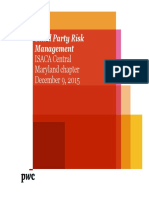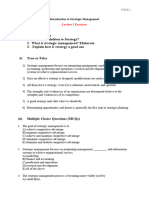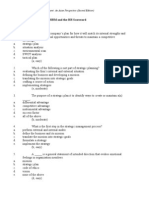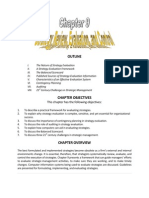12e TB Chap 13
12e TB Chap 13
Uploaded by
poopyguy12345678Copyright:
Available Formats
12e TB Chap 13
12e TB Chap 13
Uploaded by
poopyguy12345678Original Title
Copyright
Available Formats
Share this document
Did you find this document useful?
Is this content inappropriate?
Copyright:
Available Formats
12e TB Chap 13
12e TB Chap 13
Uploaded by
poopyguy12345678Copyright:
Available Formats
Chapter 13 - Strategic Control
Chapter 13
Strategic Control
Multiple Choice Questions
1. (p. 354) _______________ is concerned with tracking a strategy as it is being implemented,
detecting problems or changes in its underlying premises and making necessary adjustments.
A. Strategy evaluation
B. Strategic implementation
C. Strategic control
D. Strategic decision-making
Difficulty: Medium
Learning Objective: 1
2. (p. 354) The rapid, accelerating change of the global marketplace has made the need for
____________ key in managing a company.
A. strategic control
B. Mission clarification
C. Long-term performance
D. Alternative structures
Difficulty: Medium
Learning Objective: 1
3. (p. 354) The control of strategy can be characterized as a form of:
A. "Performance control"
B. "Mission control"
C. "Vision control"
D. "Steering control"
Difficulty: Medium
Learning Objective: 1
13-1
Chapter 13 - Strategic Control
4. (p. 355) Which of the following is NOT one of the basic types of strategic control?
A. Premise control
B. Performance control
C. Special alert control
D. Implementation control
Difficulty: Hard
Learning Objective: 1
5. (p. 356) Which of the following types of strategic control has a low degree of focusing?
A. Special alert control
B. Implementation control
C. Strategic surveillance
D. Premise control
Difficulty: Medium
Learning Objective: 1
6. (p. 356) Which of the following types of strategic control seldom is used with environmental
factors?
A. Strategic surveillance
B. Special alert control
C. Premise control
D. Implementation control
Difficulty: Medium
Learning Objective: 1
13-2
Chapter 13 - Strategic Control
7. (p. 356) ___________ is designed to check systematically and continuously whether the
premises on which the strategy is based are still valid.
A. Strategic surveillance
B. Implementation control
C. Special alert control
D. Premise control
Difficulty: Medium
Learning Objective: 1
13-3
Chapter 13 - Strategic Control
8. (p. 357) ___________ is designed to monitor a broad range of events inside and outside the
firm that are likely to affect the course of its strategy.
A. Special alert control
B. Strategic surveillance
C. Premise control
D. Implementation control
Difficulty: Medium
Learning Objective: 1
9. (p. 357) Strategic surveillance must be kept:
A. As focused as possible
B. As unfocused as possible
C. As fast as possible
D. Internal
Difficulty: Medium
Learning Objective: 1
10. (p. 357) A(n) _____________ is the thorough and often rapid, reconsideration of the firm's
strategy because of a sudden, unexpected event.
A. Special alert control
B. Implementation control
C. Milestone control
D. Premise control
Difficulty: Medium
Learning Objective: 1
13-4
Chapter 13 - Strategic Control
11. (p. 358) _____________ is designed to assess whether the overall strategy should be changed
in light of the results associated with the incremental actions that implement the overall
strategy.
A. Strategic surveillance
B. Special alert control
C. Premise control
D. Implementation control
Difficulty: Medium
Learning Objective: 1
12. (p. 360) __________ provide managers with information that helps them determine whether
the overall strategy is progressing as planned or needs to be adjusted.
A. Strategic threats
B. Strategic thrusts
C. Milestone reviews
D. Frequency reviews
Difficulty: Medium
Learning Objective: 1
13. (p. 360) The __________ that take place usually involve a full-scale reassessment of the
strategy and of the advisability of continuing or refocusing the firm's direction.
A. Abandonment reviews
B. Milestone reviews
C. Strategic thrusts
D. Strategic implementation
Difficulty: Medium
Learning Objective: 1
13-5
Chapter 13 - Strategic Control
14. (p. 361) Which of the following is NOT one of the steps necessary for operational control
systems to be effective?
A. Measure post-action performance
B. Set standards for performance
C. Initiate corrective action
D. Identify deviations from standards set
Difficulty: Medium
Learning Objective: 1
15. (p. 361) The _______ is of particular interest because it provides a basis for examining
suggested actions and for finalizing decisions on changes or adjustments in the firm's
operations.
A. Progress to date
B. Simple ranking
C. Current deviation
D. Operational standard
Difficulty: Medium
Learning Objective: 1
16. (p.363) Robert Kaplan and David Norton created the _________, a management control
system that enables companies to clarify their strategies, translate them into action and
provide quantitative feedback as to whether the strategy is creating value, leveraging core
competencies, satisfying the company's customers and generating a financial reward to its
shareholders.
A. Balance-matrix
B. Shareholder methodology
C. Balanced scorecard
D. Strategic approach
Difficulty: Easy
Learning Objective: 2
13-6
Chapter 13 - Strategic Control
17. (p. 363) The ___________ typically uses measures like cash flow, return on equity, sales and
income growth as part of the balanced scorecard approach.
A. Customer perspective
B. Business process perspective
C. Learning and growth perspective
D. Financial perspective
Difficulty: Easy
Learning Objective: 2
18. (p. 365) A ______ is a user interface that organizes and presents information from multiple
digital sources simultaneously in a user-designed format on the computer screen.
A. Wiki
B. Genie
C. Dashboard
D. Widget
Difficulty: Easy
Learning Objective: 3
19. (p. 365) Strategic controls and comprehensive control programs like the _________ bring the
entire management task into focus.
A. Capital budgeting
B. Balanced scorecard
C. Financial budgeting
D. Sales budgeting
Difficulty: Easy
Learning Objective: 3
13-7
Chapter 13 - Strategic Control
20. (p. 367) The overriding goal of a control system is to enable the ____ and ________ of the
business.
A. Improvement, diversification
B. Process, development
C. Survival, long-term success
D. Invention, entrepreneurship
Difficulty: Easy
Learning Objective: 3
Essay Questions
21. Define strategic control. How is this different from post-action control?
Please refer to the introductory discussion on page 354.
Learning Objective: 1
22. What is premise control? Identify and give examples of some environmental and industry
factors.
Please refer to the discussion titled "Premise Control" on pages 355-357.
Learning Objective: 1
23. Define strategic surveillance. How does the nature of strategic surveillance differ from
that of premise controls?
Please refer to the discussion titled "Strategic Surveillance," on page 357.
Learning Objective: 1
13-8
Chapter 13 - Strategic Control
24. What is implementation control? Identify the two basic types.
Please refer to the discussion titled "Implementation Control," on page 358-360.
Learning Objective: 1
25. Describe the balance scorecard methodology. Why is it used?
Please refer to the discussion titled "The Balanced Scorecard Methodology," on pages 363367.
Learning Objective: 2
13-9
You might also like
- Strategic Management MCQ and Answers For MBA StudentsDocument11 pagesStrategic Management MCQ and Answers For MBA Studentsmarieieiem100% (4)
- Azure DevOps Explained Get Started With Azure DevOps and Develop Your DevOps PracticesDocument497 pagesAzure DevOps Explained Get Started With Azure DevOps and Develop Your DevOps Practicesvishal jain100% (2)
- Chapter 3 Human Resource Management Strategy and AnalysisDocument9 pagesChapter 3 Human Resource Management Strategy and Analysisعبدالرحمن علاءNo ratings yet
- Strategic Management Objective QuestionsDocument70 pagesStrategic Management Objective QuestionsJose Sebastian50% (2)
- Chapter 11 Evaluation and Control: Strategic Management & Business Policy, 13e (Wheelen/Hunger)Document23 pagesChapter 11 Evaluation and Control: Strategic Management & Business Policy, 13e (Wheelen/Hunger)albertNo ratings yet
- SHRM MCQ PDFDocument11 pagesSHRM MCQ PDFneha100% (3)
- Third Party Risk Management ISACA Central Maryland Chapter December 9, 2015Document44 pagesThird Party Risk Management ISACA Central Maryland Chapter December 9, 2015Mahija_Handarbeni100% (3)
- Template and Example For Baseline Schedule NarrativeDocument25 pagesTemplate and Example For Baseline Schedule NarrativeMukul Bahuguna75% (4)
- Multiple Choice Questions: Strategic ControlDocument11 pagesMultiple Choice Questions: Strategic Controlrishika rsh100% (1)
- Strategic Management Planning For Domestic Global Competition Pearce 13th Edition Test BankDocument27 pagesStrategic Management Planning For Domestic Global Competition Pearce 13th Edition Test BankAmy Santana100% (42)
- Test Bank For Strategic Management Formulation Implementation and Control 12th Edition John A PearceDocument26 pagesTest Bank For Strategic Management Formulation Implementation and Control 12th Edition John A PearceLloyd Spells100% (28)
- Strategic Management or Strategy - 3Document85 pagesStrategic Management or Strategy - 3Akshay SapraNo ratings yet
- Multiple Choice Questions: Strategic ManagementDocument25 pagesMultiple Choice Questions: Strategic ManagementAbhiram Kotthas100% (1)
- Imanet: Product Type: DemoDocument10 pagesImanet: Product Type: DemoBupe ChaliNo ratings yet
- Final Chpater 13Document11 pagesFinal Chpater 13Eric Tonata 杜家梁No ratings yet
- MCQs in SM 1Document12 pagesMCQs in SM 1Satish Varma60% (5)
- MCQ Questions On Strategy EvaluationDocument6 pagesMCQ Questions On Strategy Evaluationsyedqutub1686% (7)
- Lect 1 QuesDocument3 pagesLect 1 QuesFarah TarekNo ratings yet
- Strategic Management MCQSDocument19 pagesStrategic Management MCQSJay Patel80% (5)
- Test Item File Ch03Document18 pagesTest Item File Ch03Brenda L Snell-Wells100% (1)
- Untitled DocumentDocument6 pagesUntitled DocumentAndrea TaganginNo ratings yet
- PaDocument9 pagesPaGotta Patti HouseNo ratings yet
- TỔNG HỢP CUỐIDocument258 pagesTỔNG HỢP CUỐILê Quốc KhánhNo ratings yet
- CIPS Strategy Review Eval Control-2Document8 pagesCIPS Strategy Review Eval Control-2Mohammed H. SalemNo ratings yet
- 2 Sem Advanced Strategic ManagementDocument20 pages2 Sem Advanced Strategic Managementsruthi kjNo ratings yet
- 3a. MGT101 Week 4 Tutorial 3 QsDocument5 pages3a. MGT101 Week 4 Tutorial 3 QsYing QianNo ratings yet
- Multiple Choice Questions: Organizational StructureDocument30 pagesMultiple Choice Questions: Organizational Structurezty435012333No ratings yet
- Startegic Management MCQsDocument18 pagesStartegic Management MCQsMuqaddas ZulfiqarNo ratings yet
- mgmt09 Tif08Document30 pagesmgmt09 Tif08Sishi WangNo ratings yet
- Multiple Choice Chapter 1Document10 pagesMultiple Choice Chapter 1Koko Dandash100% (2)
- Assignment 9Document2 pagesAssignment 9poddarprateek1No ratings yet
- Planning TestDocument4 pagesPlanning TestNitin SharmaNo ratings yet
- SM-khoa-truoc-da-sort - Strategic ManagementDocument25 pagesSM-khoa-truoc-da-sort - Strategic ManagementYen HoangNo ratings yet
- Multiple Choice Questions: ImplementationDocument28 pagesMultiple Choice Questions: Implementationzty435012333No ratings yet
- Handouts For Chapter 1, 2, 3, 4.Document19 pagesHandouts For Chapter 1, 2, 3, 4.Jamil Hassan KhattakNo ratings yet
- The Goal of Strategic Management Is ToDocument4 pagesThe Goal of Strategic Management Is ToelmarcomonalNo ratings yet
- Medel Question Paper, Introduction To ManagementDocument21 pagesMedel Question Paper, Introduction To ManagementakshayNo ratings yet
- Quiz I - Intro To STR MGMTDocument5 pagesQuiz I - Intro To STR MGMTSuraj Sapkota100% (1)
- COBIT 2019 Pytania EgzaminacyjneDocument8 pagesCOBIT 2019 Pytania EgzaminacyjneRadoslaw SosnowskiNo ratings yet
- Advanced Strategic Management (Set 1)Document22 pagesAdvanced Strategic Management (Set 1)devanshtyagi316No ratings yet
- Strategic Management Mcqs Unit 1Document15 pagesStrategic Management Mcqs Unit 1Hemant Kumar AhirwarNo ratings yet
- BBA Unit-4 Corporate StrategyDocument18 pagesBBA Unit-4 Corporate Strategyanimesh_anushNo ratings yet
- Chapter 9Document10 pagesChapter 9shaniah14100% (4)
- Strategic Management 3rd Year MGMT 2013Document2 pagesStrategic Management 3rd Year MGMT 2013ሻሎም ሃፒ ታዲNo ratings yet
- Production Management MCQSDocument13 pagesProduction Management MCQSalijanabbas258No ratings yet
- Chapter 3Document19 pagesChapter 3ageoshyNo ratings yet
- Advanced Strategic Management Solved MCQs (Set-1)Document6 pagesAdvanced Strategic Management Solved MCQs (Set-1)Wubie Bantie100% (2)
- A BUM's Strategic Planning And Critical Thinking ApproachFrom EverandA BUM's Strategic Planning And Critical Thinking ApproachNo ratings yet
- PMI-PBA Exam Success :A Practical Guide to Ace Business Analysis QuestionsFrom EverandPMI-PBA Exam Success :A Practical Guide to Ace Business Analysis QuestionsNo ratings yet
- CISA EXAM-Testing Concept-Roles of various functionsFrom EverandCISA EXAM-Testing Concept-Roles of various functionsRating: 1.5 out of 5 stars1.5/5 (2)
- Best Practices in Talent Management: How the World's Leading Corporations Manage, Develop, and Retain Top TalentFrom EverandBest Practices in Talent Management: How the World's Leading Corporations Manage, Develop, and Retain Top TalentNo ratings yet
- Quality ManagementDocument36 pagesQuality ManagementMohammed Hussien100% (5)
- Hàm ý khoa họcDocument5 pagesHàm ý khoa họcTHUONG CRUYANG HOAINo ratings yet
- Change Management Using AKDAR ModelDocument33 pagesChange Management Using AKDAR ModelNevets NonnacNo ratings yet
- ETom Framework Process and DomainDocument12 pagesETom Framework Process and DomainRhulli VentitresNo ratings yet
- Green HRM Practices of Foreign Banks inDocument33 pagesGreen HRM Practices of Foreign Banks inRudro Dipu60% (5)
- How To Use Microsoft Project 2007 in The ProjectDocument34 pagesHow To Use Microsoft Project 2007 in The Projectshalini mathurNo ratings yet
- PMBOK Workflow 1Document1 pagePMBOK Workflow 1Mark Aspinall - Good Price Cambodia100% (1)
- JD For Digital Marketing ExecutiveDocument1 pageJD For Digital Marketing ExecutiveShahrukh KhanNo ratings yet
- Interloop: Pom AssignmentDocument9 pagesInterloop: Pom AssignmentALI SHER HaidriNo ratings yet
- Ge Six SigmaDocument14 pagesGe Six SigmagauravnanjaniNo ratings yet
- Logistics Execution Integration in SAP SDDocument2 pagesLogistics Execution Integration in SAP SDtosik33721No ratings yet
- Adidas (Latest) 1Document21 pagesAdidas (Latest) 1Jalila Abd. MuktiNo ratings yet
- Education and Training of Records Management ProfessionalDocument6 pagesEducation and Training of Records Management ProfessionalAfiqah Kamarulzaman0% (1)
- Lean Vs Green ManufacturingDocument11 pagesLean Vs Green ManufacturingAnura BandaraNo ratings yet
- Priya Chugh SOP-123Document4 pagesPriya Chugh SOP-123Priya ChughNo ratings yet
- Manager Form HospitalDocument4 pagesManager Form Hospitalmahsa choopNo ratings yet
- Chapter 14 Managing Strategic ChangeDocument16 pagesChapter 14 Managing Strategic ChangeJenish RanaNo ratings yet
- Curriculum Vitae JumaDocument6 pagesCurriculum Vitae JumaEvance JumaNo ratings yet
- ISO 50001 Dan Managemen EnergiDocument27 pagesISO 50001 Dan Managemen Energiabdul lubisNo ratings yet
- Notice-FINSTARA RecruitmentDocument3 pagesNotice-FINSTARA Recruitmentmuazkhan7253No ratings yet
- 20 Highlights For Cash Flow AnalysisDocument23 pages20 Highlights For Cash Flow Analysismaruf_tanmimNo ratings yet
- Cover Letter - Bryan Garnier & CoDocument1 pageCover Letter - Bryan Garnier & CoNathan CrossonNo ratings yet
- Circle The One Letter You Deem Correct in Each of The Following Multiple QuestionsDocument4 pagesCircle The One Letter You Deem Correct in Each of The Following Multiple QuestionsJpbNo ratings yet
- Feedback - MOCKP1B1Document24 pagesFeedback - MOCKP1B1Raman ANo ratings yet
- Earned Value AnalysisDocument12 pagesEarned Value AnalysisziaarkiplanNo ratings yet
- Johnson and JohnsonDocument3 pagesJohnson and Johnsons143567No ratings yet
- Restaurant Manager Interview QuestionsDocument3 pagesRestaurant Manager Interview Questionsclarissa100% (1)

























































































